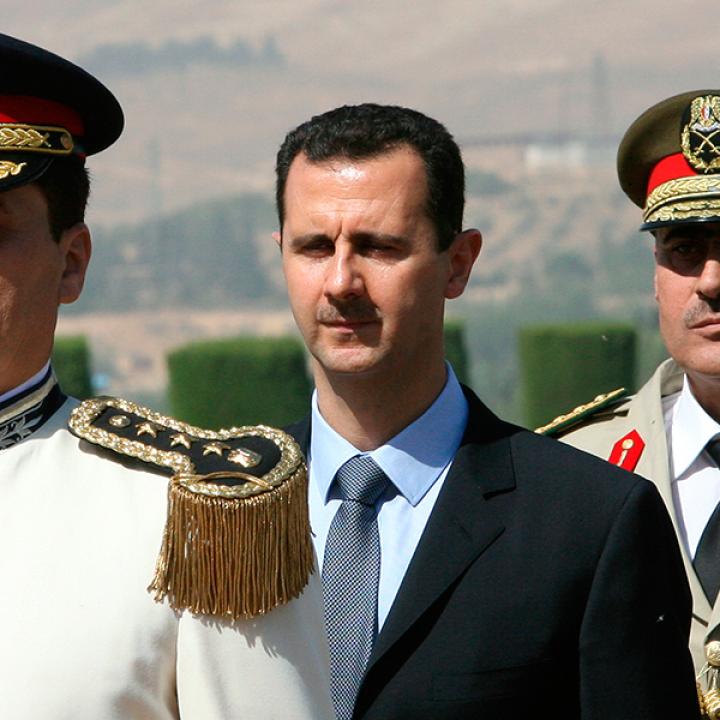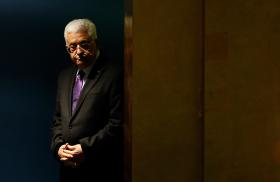
- Policy Analysis
- Fikra Forum
Can Assad’s Demobilization, Demilitarization, and Rehabilitation Strategy Actually Consolidate Syria’s Paramilitary Forces?

After eight years of conflict, Syrian president Bashar al-Assad appears to have emerged victorious over his areas of control and seems set to expand his power over Syria once again. The regime has spearheaded its consolidation efforts by working towards integrating loyalist and rebel militias into the Syria army. Yet Assad appears to favor a progressive yet partial approach to demobilization, demilitarization, and rehabilitation (DDR) that could later prove challenging to his goal of an integrated military force. Assad’s current approach may not be adequately equipped to handle loyalist factions’ regional alignments with other states. It is likely to struggle with the highly ideological training these fighters have received under the aegis of Iran, in addition to the high number of foreign militants who remain on Syrian soil.
According to a high-level commander in a pro-regime paramilitary group who spoke to the author, “the Syrian government is progressively incorporating pro-regime paramilitary. In [this] first phase, [the government is] forcing [these paramilitary] members [who meet] conscription conditions such as age to join the Syrian army, while those who do not [meet conscription conditions] remain in their respective groups.”
Regarding those militias that fought against the Syrian army, the commander notes that these forces “fall under taswiyat al-wadaa [settlement]; [these] fighters are typically given the chance to settle their affairs with their former paramilitary group and register with the local military recruitment branch instead.” Researchers such as Haid Haid have also noted this process of obligatory conscription applied to both pro-regime and anti-regime rebel opposition groups whose members are between the ages of 18 and 42. The latter are targeted through the government’s taswiyat policies applied in areas that have been brought back under its control.
The source explains that the only militias that have been permanently dissolved are those that have faced general accusations of abuse. For example, the Syrian government disbanded the private militia Desert Hawks Brigade (Liwa Suqur al-Sahara), led by Colonel Mohammad Jaber and financed by his brother, the businessman Ayman Jaber, over charges of abuse. Other groups such as Maghawir Bahr, also financed by Jaber, have been dissolved due to similar accusations.
In other cases, groups have dispersed after the funds to support their fighters dried up. In February 2018, the Syrian Observer reported that approximately half of the paramilitaries fighting alongside Assad's forces in the Houla area and the northern countryside of Homs province have abandoned their groups to join the regime army after their former paramilitary units failed to pay them for six months. Members of the Al-Bustan Association militia have joined the regime army for similar reasons.
Other methods designed to create a more cohesive fighting force include the creation and management of paramilitary units under the apparent authority of Syrian army battalions that nevertheless maintained distinct unit identities. Such has been the case of groups such as the Dara‘ al-Qalamoun (Qalamoun Shield) and the Latakia-based Dara‘ al-Sahel (Coastal Shield) militias—both formed in the past few years and, according to a Carnegie Diwan article, ostensibly placed under the authority of the Republican Guard. Adding to this process, the Republican Guard also reportedly formed the 30th Division designed as an umbrella organization for Aleppo’s local militias while retaining independent operating structures.
There remains some confusion as to whether these units retain distinct operational structures despite their apparent assimilation into the Syrian army. In 2017, the Russian government-affiliated Russian International Affairs Council noted reports that Dara’ Al-Qalamoun had already been integrated in the Syrian army’s Fifth Corp. Contradicting statements on the status of paramilitary integration into the Syrian army underline that this integration process remains very fluid and is highly dependent on both regime interests and power plays of its backers.
Nonetheless, it is clear is that this policy of integration has its limits. As the Syrian paramilitary source argued: “The Syrian army does not have (for the time being) the financial capacity to absorb all pro-regime paramilitary, which explains the [integration] exception made for certain factions such as the Local Defense Forces (LDF).” The LDF—a paramilitary force trained and financed by Iran—was officially incorporated into the state’s military apparatus and has coordinated with Syrian general command since 2017. Yet documents posted by researcher Aymen Jawada Tamimi underline that the LDF was to remain under Iranian leadership until the “crisis” [i.e. the Civil War] in Syria ended. Under this arrangement, “The leadership of the local defense units in the provinces that work with the Iranian side remain affiliated with the Iranian side while coordinating with the general command for the army and armed forces until the end of the crisis in the Syrian Arab Republic, or issuing of a new decision.”
Allowing the continuing alignment of powerful paramilitaries with external forces in order to defray the considerable costs of military expenditures is not without risks to the Assad regime. Iran in particular has had a successful track record creating, nurturing, and empowering local militias in the region that it can later rely on as powerful and devoted proxies. Such has been the case with both Hezbollah in Lebanon and the pro-Tehran wing of the Iraqi Popular Mobilization Forces.
Adding to this perception is the boast of a Hezbollah commander who spoke recently to the author in Beirut, saying that “Iran has built a resistance like Hezbollah in Syria and that force will remain operational there,” rejecting the possibility that the LDF will ever be dissolved and subdued to Syrian central command. Nevertheless, Iranian Defense Minister Amir Hatami publicly stated in August of last year that even Hezbollah itself was only in Syria at the request of the government and that the two were in close coordination with one another, suggesting an Iranian interest in maintaining the image of pro-regime efforts operating under the control of the Syrian army.
The challenge of integrating forces with foreign backing is compounded by the large number of pro-regime foreign fighters who remain deployed in Syria. In a previous interview with the author, Syria expert Samir Hassan estimated that as of 2018, Iran has deployed over 34,000 foreign fighters in Syria. These figures include the Afghani Fatemeyoun, the Pakistani Zainabiyoun, and the Iraqi Haydareyoun, all in addition to the continuing presence of Lebanese Hezbollah.
And while Hezbollah has significantly reduced its deployment in Syria according to sources within the organization, it is difficult to precisely quantify how many of its fighters are still present on Syrian soil and what type of control they project in their areas of influence. For example, Hezbollah appears to have maintained bases in strategic areas such as the Homs governorate, Aleppo, and southern Syria—the latter despite Russia’s agreement to keep Iranian influence away from the border with Israel.
Direct foreign involvement aside, regime consolidation efforts are also threatened by the ideological training combatants have undergone—driven both by the sectarian nature of the conflict and the interests of foreign support. A previously interviewed Hezbollah trainer focused his description of training efforts on the importance of ideological training provided by the group to pro-regime Syrian militias. Opposition fighters have also radicalized through information disseminated by extremist organizations, ranging from mainstream Islamic militias to ISIS. Thus, ideological and religious rehabilitation of those militias the Syrian army is attempting to integrate—both pro- and anti-regime—represent an essential component of the consolidation process. The regime appears to be aware of this danger; according to the paramilitary commander, reintegrated soldiers must attend political reorientation programs and classes in Ba’ath party ideology as a way of supplanting former ideologies. Yet the efficacy of this ‘reorientation’ process remains to be seen.
Ultimately, if Assad seeks to regain true military control of Syria, foreign fighters on both sides of the conflict will have to be identified as soon as possible, disarmed, and transported to secure facilities. Other forms of foreign influence—including ideological training and foreign leadership—will also have to be carefully assessed and extracted. Though this process requires resources and leverage that the Assad regime is unlikely to possess for the time being, the stakes are correspondingly high—the regime has only to look to its western neighbor to see what a failed DDR policy can do to a country. Nearby Lebanon is a painful reminder of how long-term peace can remain elusive decades after a conflict when the militarization of the state and sectarian fragmentation allows for continuing paramilitary structures within its borders.


